Getting people to sign up for a trial won’t mean anything if you can’t get them to purchase your product.
In order to get users to start giving you their money, you have to build SaaS onboarding funnels.
And do it correctly.
So what are SaaS onboarding funnels?
SaaS Onboarding Funnel: The critical period between someone signing up for a trial, for however long that is, until they start paying for their usage and their account.
Essentially, a SaaS onboarding funnel is a process or series of steps that takes people from aware or trying your brand or product to actually giving you money for it.
As the product creator, business owner or marketer you have two objectives (or primary goals) once users sign up for a trial and enter the funnel.
The Two Primary Goals of SaaS Onboarding:
- To Get Users to Pay (more on this further down)
- Guide Users into Having an Aha! Moment
You are very unlikely to get number one without accomplishing number two first.
The rest of this post will be a very intimate look into helping your customers get an Aha! moment about your product.
So, What is an Aha! Moment?
To put it simply the Aha moment for your trial users is when they realize exactly how your software fits into (and improves) their overall process.
When users figure out how they’re going to use what you sell with what they use it for—the Aha moment will click for them.
Getting them to Aha takes, what I call, a series of Revelations.
Well, What is a Revelation Then?
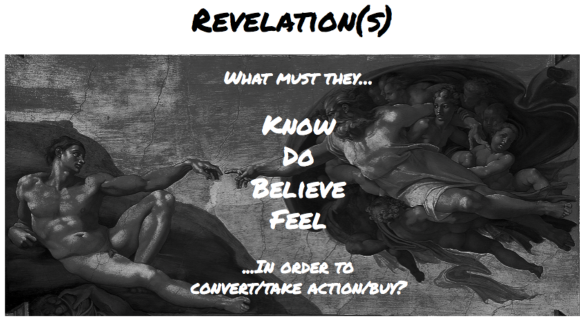
In short, a revelation is what that users need to:
- Know
- Do
- Believe
- Feel
All in order that they might actually buy. Each of these steps work together to create the ideal scenario in which your ideal users will have the greatest chance of purchasing.
The most important of these? Believe.
Belief is where behavior changes.
If you can’t change their beliefs, you won’t be able to change behavior.
If you can get users to go from being inquisitive about what your software does to actually thinking it can work for them you will have a successful onboarding funnel.
Here’s how to do it.
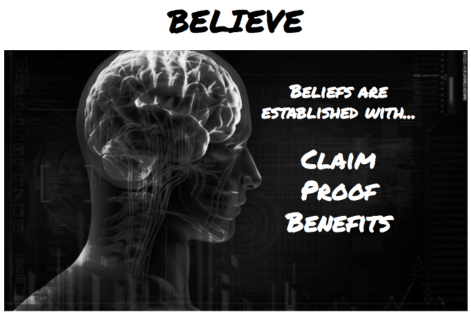
There are 3 elements that factor into establishing a belief. They are:
- Claim: Stating the ability of your software or a particular feature of your software.
- Proof: Showing how a particular claim is accomplished or a case study of how someone has accomplished your claim.
- Benefits: The advantages of using your software or those particular features to accomplish the same results for the user.
How Do I Figure Out a Claim that My Product Has?
The best place in the world to go in order to find a claim that you or your product can lay hold of is by talking to your customers who clearly love your software.
Sure, you may know the features that you built. That said, you may not know the exact way in which your users are using them.
The claims you make about your software should be clear, and if it’s not — you have some work to do.
Qualitative research will need to take place if there are no clear revelations, claims or Aha moments to be had.
Talk to people who left. Then, talk to people who are still there. Ask open-ended questions and figure out why they are leaving and what you need to do.
Let’s break down what we got so far.
- The Aha moment is how your overall software will help users accomplish the goal that you intended.
- Revelations are like smaller Aha moments, based on the claims that you’re making about features of your product.
Now, we take this information and turn it into your onboarding funnel.
3 Elements of Highly Effective Onboarding Funnels
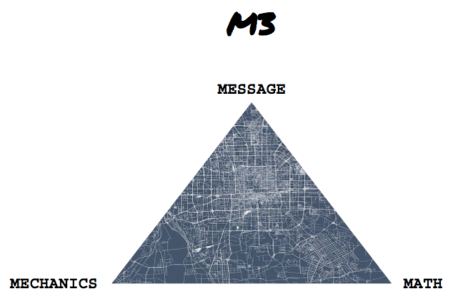
There are 3 elements to a highly effective onboarding funnel:
- Message: Communicating those revelations and beliefs into a series of messages.
- Mechanics: How those messages are delivered ( i.e. email, social media, etc).
- Math: Breaking down the numbers that matter in your funnel (i.e. customer acquisition, the frequency of messages, etc.).
Message Mapping

The end goal is Aha! Which should lead to a paid account.
However, we can’t start there. It all begins with the messaging. And if the endpoint is aha, we have to figure out where your users begin. This is called message mapping.
It’s obvious that the beginning of your onboarding funnel should be an ideal user (that fits your buyer persona) signing up for a trial. But what you may not know are things like;
- What do they believe at the beginning of the trial?
- What do you want them to know by the end?
In many cases, users will begin your onboarding funnel with hope. Hope that a certain feature will save them struggle or a headache. Or hope to accomplish goals faster by using your product for its intended purpose.
These are the people you should be marketing towards, and these are the people who should be signing up for trials.
Now, map that overarching message. It will need to have the claims and revelations that take them from their hopes to beliefs that your product is the one to fulfill those desires (see above image).
List out your features or the claims that you hope to make that best suit your ideal buyer persona. Then, think about a few other things like;
- How many messages do you need to go from hope to Aha?
- What behavior constitutes a good user that is likely to buy?
- Which order should you put your beliefs/revelations?
Once you do these things, it’s time to flesh out those revelations and get users to believe.
From Hope to Belief Through Revelation (and Good Copy)
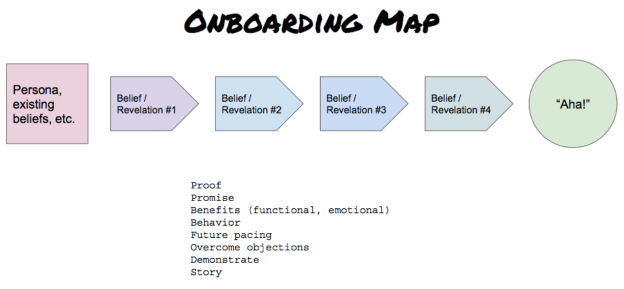
There are many tools in the marketer’s tool bag to communicate these revelations to users. Here just a few;
- Proof
- Promise
- Benefits
- Behavior
- Future-pacing
- Overcome objections
- Demonstrate
- Story
Essentially, these are themes and frameworks to communicate the revelations that you map out.
How About a Couple Examples?
Early on in an onboarding funnel, it could be helpful to demonstrate how a certain feature works.
This is especially true if a majority of your users sign up for trial for a particular feature. You want your users to have a successful run with that feature and a demonstration can help.
Let’s put everything into perspective:
- The user signed up for a trial and hopes that the feature would accomplish what you said it would.
- Then, you send an email with a short video demonstrating how to use that exact feature.
- Finally, that initial hope or claim that you made has been proven. And the user has been given a revelation.
Make sense?
Delivering Your Message to Users
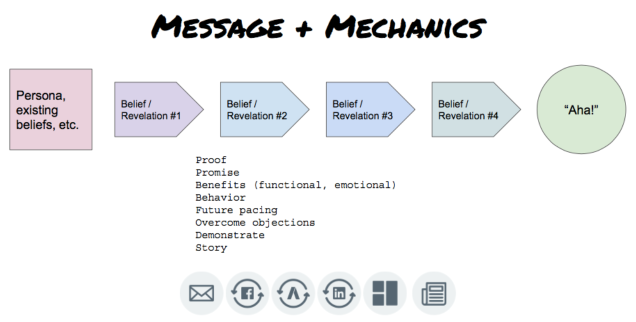
I won’t spend much time here, but this is the means at which you communicate your message.
Important tip: Variety, not just email. Too many marketers will just send three or four emails and hope for the best. It does not work as well as multiple formats of communication.
Maybe you send an email once they successfully sign up for the trial. In the email, you include a demonstration of your key feature (like we talked about above).
If the user is engaging with said feature, perhaps one of your reps reaches out via social media — or even a phone call.
Depending on how deep you want to get, there can be a lot of “if this, then that” in your onboarding funnel.
If users are making certain indicators, it could be a sign. Then, you may want to reach out and make “an offer they can’t refuse” to mitigate the pain of paying.
For instance, you can offer something in exchange for them to go ahead, end their trial and sign up for your product. Things like;
- A free one-hour consulting call
- 30 days of office hours access to the CEO
- Upgraded features or discounts
Of course, all of this depends on whether or not the math checks out.
Get Out Your Calculators
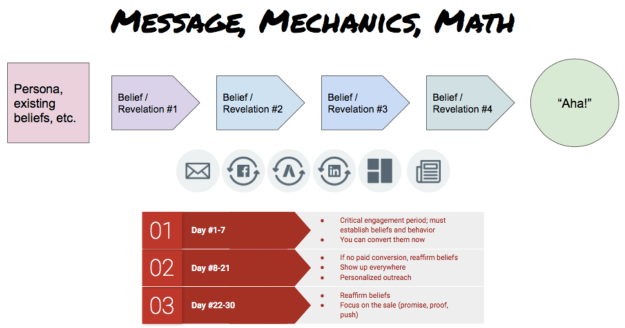
The term math is very loose. Math can cover;
- Lifetime value (LTV)
- Customer acquisition cost (CAC)
- Conversion goals/needs
- Length of onboarding sequence (e.g. the number of messages)
If you’ve never set up an onboarding funnel, many of these numbers you’ll discover over time. And since we don’t have your numbers, like your marketing dollars, present — let’s just go over the length of your onboarding funnel.
Days 1-7: This is the critical week. If any of your trial users are active on your software you want to make them a deal or an offer within Days 1 through 7.
Days 8-21: During this time you want to try to be everywhere. Retargeting, sales team reaching out, sending email follow-ups.
Days 22-30: There should be no question by the end of the trial.Every user should know that in order to continue they’ll have to pay.
Key Tip: You’ll have a hard time converting over 30 days. Don’t wait till day 30 to sell them. Ideally, try making an offer to active users within the first week.
Let’s Recap SaaS Onboarding Funnels…
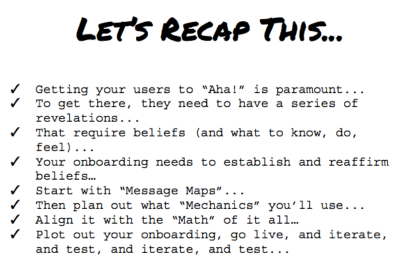
Find out why your ideal users can’t live without your software. Ask your users how they came to that Aha moment (via good questions).
Work backward to figure out your overall messaging, including the revelations they’ll need to get to the AHA.
Once your messaging is mapped out, it’s time to get into logistics.
Figure out the formulas for your copy, the means to deliver your messages (i.e. email) and the time frame of your overall onboarding funnel.
Align everything with math. Make sure it all works profitably.
Finally, keep iterating and testing.
Even if it works well from the start, you can always make adjustments and improvements.
It’s in the testing that growth really happens.